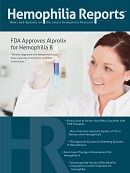Publication
Article
Hemophilia Reports
Extending Time Between Infusions for Pediatric Hemophilia
Author(s):
Recombinant factor VIII treatment for pediatric hemophilia can extend time between infusions.

Recombinant factor VIII treatment for children can extend time between infusions, according to research published in the Journal of Thrombosis and Haemostasis.
Researchers from the Children’s Hospital Los Angeles studied 71 subjects in order to test the safety, efficacy, and pharmacokinetics of a longer acting factor recombinant factor FVIII fusion protein (rFVIIIFc). Previously, rFVIIIFc was used to treat children with severe hemophilia A, the researchers said. Additionally, they said, under dosing is common because frequent intravenous infusions (3-4 times weekly) are required for prophylactic factor replacement.
The patients were initially administered twice weekly prophylaxis rFVIIIFc. On Day 1, patients got 25 IU kg−1 and on Day 4, 50 IU kg−1 at doses of ≤ 80 IU kg−1. The dosing interval (≥ 2 days) was adjusted as needed. A few patients underwent pharmacokinetic evaluations of FVIII and rFVIIIFc, where the primary endpoint was development of inhibitors, the neutralizing antibodies. The researchers also examined the secondary endpoints including pharmacokinetics, annualized bleeding rate, and number of infusions required to control a bleed.
There were no patients who developed an inhibitor to rFVIIIFc. The adverse events that did occur were typical of pediatric hemophilia cases, the researchers wrote. The rFVIIIFc half life was longer when compared to the half life of FVIII, the investigators determined, which was aligned with observations done on adolescents and adults with hemophilia.
The median annualized bleeding rate was 1.96 overall, but 0.00 for spontaneous bleeds. A little less than half of the subjects (46.4 percent) reported no bleeding episodes throughout the study. The researchers added that 93 percent of all bleeding episodes were controlled using 1 to 2 infusions.
“Children’s Hospital Los Angeles is home to one of the largest hemophilia treatment centers in the world,” study leader Guy Young, MD, who is also an associate professor of pediatrics at the Keck School of Medicine of the University of Southern California, explained in a press release. “Through clinical trials, we are able to offer our patients the very latest treatments, often before they are available anywhere else. In this trial, we demonstrated the safety and efficacy of a medication that will allow children with severe hemophilia A to be treated with a safe and effective medicine but with a reduced burden of the treatment.”
The researchers added that the median average weekly rFVIIIFc prophylactic dose was 88.11 IU kg−1. By the end of the study, the authors said, 62 of 69 subjects (90 percent) were infusing twice weekly. And for the subjects who had been previously receiving FVIII prophylaxis, three quarters of those patients reduced their dosing with rFVIIIFc.
